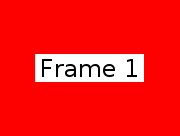With 5 images I have to create a video of 60 seconds in ffmpeg, each image has to display for 15 seconds. after 15 seconds, first image has to fade out and 2nd image has to fade in, after that 2nd image has to fade out, 3rd image has to fade in..etc. Please guide me how can I achieve this using ffmpeg commands.
2 Answers
Dip/fade to black
Scroll down for crossfade method.

Example where each image displayed for 5 seconds and each has a fade that lasts 1 second. Each image input has the same width, height, and sample aspect ratio. If they vary in size see example #3 below.
MP4 output
ffmpeg \
-loop 1 -t 5 -i input0.png \
-loop 1 -t 5 -i input1.png \
-loop 1 -t 5 -i input2.png \
-loop 1 -t 5 -i input3.png \
-loop 1 -t 5 -i input4.png \
-filter_complex \
"[0:v]fade=t=out:st=4:d=1[v0]; \
[1:v]fade=t=in:st=0:d=1,fade=t=out:st=4:d=1[v1]; \
[2:v]fade=t=in:st=0:d=1,fade=t=out:st=4:d=1[v2]; \
[3:v]fade=t=in:st=0:d=1,fade=t=out:st=4:d=1[v3]; \
[4:v]fade=t=in:st=0:d=1,fade=t=out:st=4:d=1[v4]; \
[v0][v1][v2][v3][v4]concat=n=5:v=1:a=0,format=yuv420p[v]" -map "[v]" out.mp4
With audio
Same as above but with audio:
ffmpeg \
-loop 1 -t 5 -i input0.png \
-loop 1 -t 5 -i input1.png \
-loop 1 -t 5 -i input2.png \
-loop 1 -t 5 -i input3.png \
-loop 1 -t 5 -i input4.png \
-i audio.m4a \
-filter_complex \
"[0:v]fade=t=out:st=4:d=1[v0]; \
[1:v]fade=t=in:st=0:d=1,fade=t=out:st=4:d=1[v1]; \
[2:v]fade=t=in:st=0:d=1,fade=t=out:st=4:d=1[v2]; \
[3:v]fade=t=in:st=0:d=1,fade=t=out:st=4:d=1[v3]; \
[4:v]fade=t=in:st=0:d=1,fade=t=out:st=4:d=1[v4]; \
[v0][v1][v2][v3][v4]concat=n=5:v=1:a=0,format=yuv420p[v]" -map "[v]" -map 5:a -shortest out.mp4
For input images with varying or arbitrary sizes
Like the first example, but with input images that vary in width x height. They will be padded to fit within a 1280x720 box:
ffmpeg \
-loop 1 -t 5 -i input0.png \
-loop 1 -t 5 -i input1.png \
-loop 1 -t 5 -i input2.png \
-loop 1 -t 5 -i input3.png \
-loop 1 -t 5 -i input4.png \
-filter_complex \
"[0:v]scale=1280:720:force_original_aspect_ratio=decrease,pad=1280:720:(ow-iw)/2:(oh-ih)/2,setsar=1,fade=t=out:st=4:d=1[v0]; \
[1:v]scale=1280:720:force_original_aspect_ratio=decrease,pad=1280:720:(ow-iw)/2:(oh-ih)/2,setsar=1,fade=t=in:st=0:d=1,fade=t=out:st=4:d=1[v1]; \
[2:v]scale=1280:720:force_original_aspect_ratio=decrease,pad=1280:720:(ow-iw)/2:(oh-ih)/2,setsar=1,fade=t=in:st=0:d=1,fade=t=out:st=4:d=1[v2]; \
[3:v]scale=1280:720:force_original_aspect_ratio=decrease,pad=1280:720:(ow-iw)/2:(oh-ih)/2,setsar=1,fade=t=in:st=0:d=1,fade=t=out:st=4:d=1[v3]; \
[4:v]scale=1280:720:force_original_aspect_ratio=decrease,pad=1280:720:(ow-iw)/2:(oh-ih)/2,setsar=1,fade=t=in:st=0:d=1,fade=t=out:st=4:d=1[v4]; \
[v0][v1][v2][v3][v4]concat=n=5:v=1:a=0,format=yuv420p[v]" -map "[v]" out.mp4
See the examples in Resizing videos to fit into static sized player if you want to crop (fill the screen) instead of pad (letterbox/pillarbox), or if you want to prevent upscaling.
GIF output
Adds the filters from How do I convert a video to GIF using ffmpeg, with reasonable quality?
ffmpeg \
-framerate 10 -loop 1 -t 5 -i input0.png \
-framerate 10 -loop 1 -t 5 -i input1.png \
-framerate 10 -loop 1 -t 5 -i input2.png \
-framerate 10 -loop 1 -t 5 -i input3.png \
-framerate 10 -loop 1 -t 5 -i input4.png \
-filter_complex \
"[0:v]fade=t=out:st=4:d=1[v0]; \
[1:v]fade=t=in:st=0:d=1,fade=t=out:st=4:d=1[v1]; \
[2:v]fade=t=in:st=0:d=1,fade=t=out:st=4:d=1[v2]; \
[3:v]fade=t=in:st=0:d=1,fade=t=out:st=4:d=1[v3]; \
[4:v]fade=t=in:st=0:d=1,fade=t=out:st=4:d=1[v4]; \
[v0][v1][v2][v3][v4]concat=n=5:v=1:a=0,split[v0][v1]; \
[v0]palettegen[p];[v1][p]paletteuse[v]" -map "[v]" out.gif
Use the -loop output option to control the number of times the GIF loops. Default is infinite loop if this option is not used. A value of -1 is no loop.
Options and filters used:
-tto set duration in seconds of each input.-loop 1loops the image otherwise it would have a duration of 1 frame.-framerateto set input image frame rate (default when undeclared is 25). Useful for making GIF.scale with pad to fit the input images into a specific, uniform size (used in example #3).
fade to fade in and out.
dis the duration of the fade.stis when it starts.concat to concatenate (or "join") each image.
format to output a chroma subsampling scheme that is compatible with non-FFmpeg based players if outputting MP4 and encoding with libx264 (the default encoder for MP4 output if it is supported by your build).
split to make copies of a filter output. Needed by the palette* filters to do everything in one command.
palettegen and paletteuse for making nice looking GIF.
Crossfade
Example where each image displayed for 5 seconds and each has a crossfade that lasts 1 second. Each image input has the same width, height, and sample aspect ratio. If they vary in size then adapt example #3 above.
MP4 output
ffmpeg \
-loop 1 -t 5 -i 1.png \
-loop 1 -t 5 -i 2.png \
-loop 1 -t 5 -i 3.png \
-loop 1 -t 5 -i 4.png \
-loop 1 -t 5 -i 5.png \
-filter_complex \
"[1]format=yuva444p,fade=d=1:t=in:alpha=1,setpts=PTS-STARTPTS+4/TB[f0]; \
[2]format=yuva444p,fade=d=1:t=in:alpha=1,setpts=PTS-STARTPTS+8/TB[f1]; \
[3]format=yuva444p,fade=d=1:t=in:alpha=1,setpts=PTS-STARTPTS+12/TB[f2]; \
[4]format=yuva444p,fade=d=1:t=in:alpha=1,setpts=PTS-STARTPTS+16/TB[f3]; \
[0][f0]overlay[bg1];[bg1][f1]overlay[bg2];[bg2][f2]overlay[bg3]; \
[bg3][f3]overlay,format=yuv420p[v]" -map "[v]" -movflags +faststart out.mp4
With audio
ffmpeg \
-loop 1 -t 5 -i 1.png \
-loop 1 -t 5 -i 2.png \
-loop 1 -t 5 -i 3.png \
-loop 1 -t 5 -i 4.png \
-loop 1 -t 5 -i 5.png \
-i music.mp3 \
-filter_complex \
"[1]format=yuva444p,fade=d=1:t=in:alpha=1,setpts=PTS-STARTPTS+4/TB[f0]; \
[2]format=yuva444p,fade=d=1:t=in:alpha=1,setpts=PTS-STARTPTS+8/TB[f1]; \
[3]format=yuva444p,fade=d=1:t=in:alpha=1,setpts=PTS-STARTPTS+12/TB[f2]; \
[4]format=yuva444p,fade=d=1:t=in:alpha=1,setpts=PTS-STARTPTS+16/TB[f3]; \
[0][f0]overlay[bg1];[bg1][f1]overlay[bg2];[bg2][f2]overlay[bg3]; \
[bg3][f3]overlay,format=yuv420p[v]" -map "[v]" -map 5:a -shortest -movflags +faststart out.mp4
Crossfade between two videos with audio
Select 5 second segment from each input and add a 1 second crossfade:
ffmpeg -i input0.mp4 -i input1.mp4 -filter_complex \
"[0:v]trim=start=5:end=10,setpts=PTS-STARTPTS[v0];
[1:v]trim=start=12:end=17,setpts=PTS-STARTPTS+4/TB,format=yuva444p,fade=st=4:d=1:t=in:alpha=1[v1];
[v0][v1]overlay,format=yuv420p[v];
[0:a]atrim=start=5:end=10,asetpts=PTS-STARTPTS[a0];
[1:a]atrim=start=12:end=17,asetpts=PTS-STARTPTS[a1];
[a0][a1]acrossfade=d=1[a]" \
-map "[v]" -map "[a]" output.mp4
GIF output
ffmpeg \
-framerate 10 -loop 1 -t 5 -i 1.png \
-framerate 10 -loop 1 -t 5 -i 2.png \
-framerate 10 -loop 1 -t 5 -i 3.png \
-framerate 10 -loop 1 -t 5 -i 4.png \
-framerate 10 -loop 1 -t 5 -i 5.png \
-filter_complex \
"[1]format=rgba,fade=d=1:t=in:alpha=1,setpts=PTS-STARTPTS+4/TB[f0]; \
[2]format=rgba,fade=d=1:t=in:alpha=1,setpts=PTS-STARTPTS+8/TB[f1]; \
[3]format=rgba,fade=d=1:t=in:alpha=1,setpts=PTS-STARTPTS+12/TB[f2]; \
[4]format=rgba,fade=d=1:t=in:alpha=1,setpts=PTS-STARTPTS+16/TB[f3]; \
[0][f0]overlay[bg1];[bg1][f1]overlay[bg2];[bg2][f2]overlay[bg3];[bg3][f3]overlay,split[v0][v1]; \
[v0]palettegen[p];[v1][p]paletteuse[v]" -map "[v]" out.gif
Use the -loop output option to control the number of times the GIF loops. Default is infinite loop if this option is not used. A value of -1 is no loop.
-
1@LordNeckbeard, thanks for this answer, I used it for another example. Have I understood well that number following
-tin-loop 1 -t 1 -i 001.pngdefines the duration of individual frames, and that numbers followingT/withinfilter_complexblock defines the transition's duration? And is the frame duration in this example counted including transition's duration or not?– cincplugMay 19, 2016 at 8:27 -
1@Nisarg That does not appear to be the complete output and I'm not sure what command it is from of the two you displayed earlier. Anyway, try adding
-preset ultrafast.– lloganAug 6, 2016 at 16:06 -
1@LordNeckbeard I need to combine a set of images, video clips and an audio track to create a single video file (preferably ogg, but that is less relevant at this point). In addition, I need to create some transition effects between adjacent images. Is there any way to script this whole task using ffmpeg and/or other command line tools? The goal is to automate the task via a command line interface.– Web UserAug 17, 2016 at 17:37
-
1
-
4The ffmpeg approach is working nicely for me; thanks! One tip for newcomers to the page; in the
concat=n=9part of the command, the9comes from the 5 images in the example + 4 transitions between the images. If you're handling a different number of images, you'll need to adjust that accordingly. Mar 13, 2017 at 20:58
I wrote a general bash script that takes in a path to a folder of images, and outputs a crossfade video with ffmpeg:
https://gist.github.com/anguyen8/d0630b6aef6c1cd79b9a1341e88a573e
The script essentially looks at the images in a folder and prints out a command that is similar to the answer by @LordNeckbeard above, and executes the command. This script helps when you have many images in a folder and don't want to manually type in a depressingly long command.
-
Sorry, but your script fails with ffmpeg 3.0.1, with inputs #0 to #4 it returns:"Invalid file index 5 in filtergraph description" May 18, 2016 at 12:30
-
TobySpeight: good point, I've edited the answer to be more clear. Basically the main idea is already given by @LordNeckbeard above. This script just generalizes to many images.– anh_ng8Sep 21, 2016 at 12:54

